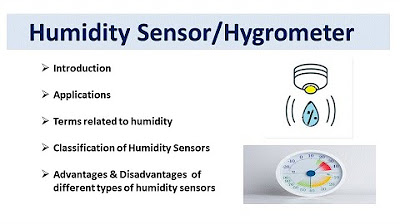What is a Sensor? Different Types of Sensors, Applications
Summary
TLDRThis video explores the essential role of sensors in everyday life and industrial processes. It defines a sensor as a device that detects changes in physical, electrical, or chemical properties and produces an electrical output. The video categorizes sensors as passive or active and highlights their various applications in process control, including measuring temperature, pressure, and flow. It emphasizes the need for transmitters to condition sensor outputs for practical use. Additionally, viewers are invited to access free and exclusive online courses on PLC programming and industrial automation through the RealPars app.
Takeaways
- 😀 Sensors are integral to daily life, impacting both home and work environments.
- 🔍 A sensor is defined as a device that detects changes and produces an electrical output.
- 🌡️ Sensors can sense various properties, including temperature, pressure, flow, level, speed, and position.
- ⚡ Sensors are classified as Active (no external power needed) or Passive (requires external power).
- 🌡️ Examples of Active Sensors include thermocouples and piezoelectric sensors.
- 📏 Examples of Passive Sensors include Resistance Temperature Detectors (RTDs) and strain gauges.
- 🔌 Sensors are often connected to transmitters to condition or amplify their outputs.
- 📊 The output voltage from sensors like thermocouples is typically very low (8 mV to 18 mV).
- 🔗 The small sensor outputs are converted to standard signals (4 mA to 20 mA) for process control applications.
- 📚 Newcomers can access free online courses on PLC hardware through the RealPars app.
Q & A
What is a sensor?
-A sensor is a device that detects changes in physical, electrical, or chemical properties and produces an electrical output in response to that change.
How do sensors impact our daily lives?
-Sensors are part of everyday life and can be found in various applications, such as traffic lights, automatic doors, and industrial process control, making tasks more efficient and convenient.
What are some physical properties that sensors can detect?
-Sensors can detect a range of physical properties, including level, temperature, flow, pressure, speed, and position.
What is the difference between passive and active sensors?
-A passive sensor requires an external source of power to operate, while an active sensor does not. For example, thermocouples are active sensors, and resistance temperature detectors (RTDs) are passive sensors.
Can you give an example of an active sensor?
-A thermocouple is an example of an active sensor, as it generates a voltage output when exposed to temperature changes without needing an external power supply.
What is the purpose of a transmitter in process control?
-A transmitter conditions or amplifies the sensor's output, making it suitable for process control applications, as sensor output voltages are often too small to be used directly.
What voltage output range can a thermocouple produce?
-A thermocouple can produce a voltage output ranging from 8 mV to 18 mV over a temperature change of 450 degrees Fahrenheit.
Why are small output voltages from sensors a concern?
-Small output voltages from sensors are a concern because they need to be amplified or conditioned for practical use in process control applications.
What does the RealPars app offer for newcomers?
-Newcomers to RealPars can access one of their online courses for free by downloading the app and selecting the first lesson of the PLC Hardware course.
What benefits does a subscription to RealPars provide?
-A subscription to RealPars offers full access to a library of exclusive courses on PLC programming and industrial automation, along with new videos released weekly.
Outlines

Cette section est réservée aux utilisateurs payants. Améliorez votre compte pour accéder à cette section.
Améliorer maintenantMindmap

Cette section est réservée aux utilisateurs payants. Améliorez votre compte pour accéder à cette section.
Améliorer maintenantKeywords

Cette section est réservée aux utilisateurs payants. Améliorez votre compte pour accéder à cette section.
Améliorer maintenantHighlights

Cette section est réservée aux utilisateurs payants. Améliorez votre compte pour accéder à cette section.
Améliorer maintenantTranscripts

Cette section est réservée aux utilisateurs payants. Améliorez votre compte pour accéder à cette section.
Améliorer maintenant5.0 / 5 (0 votes)






